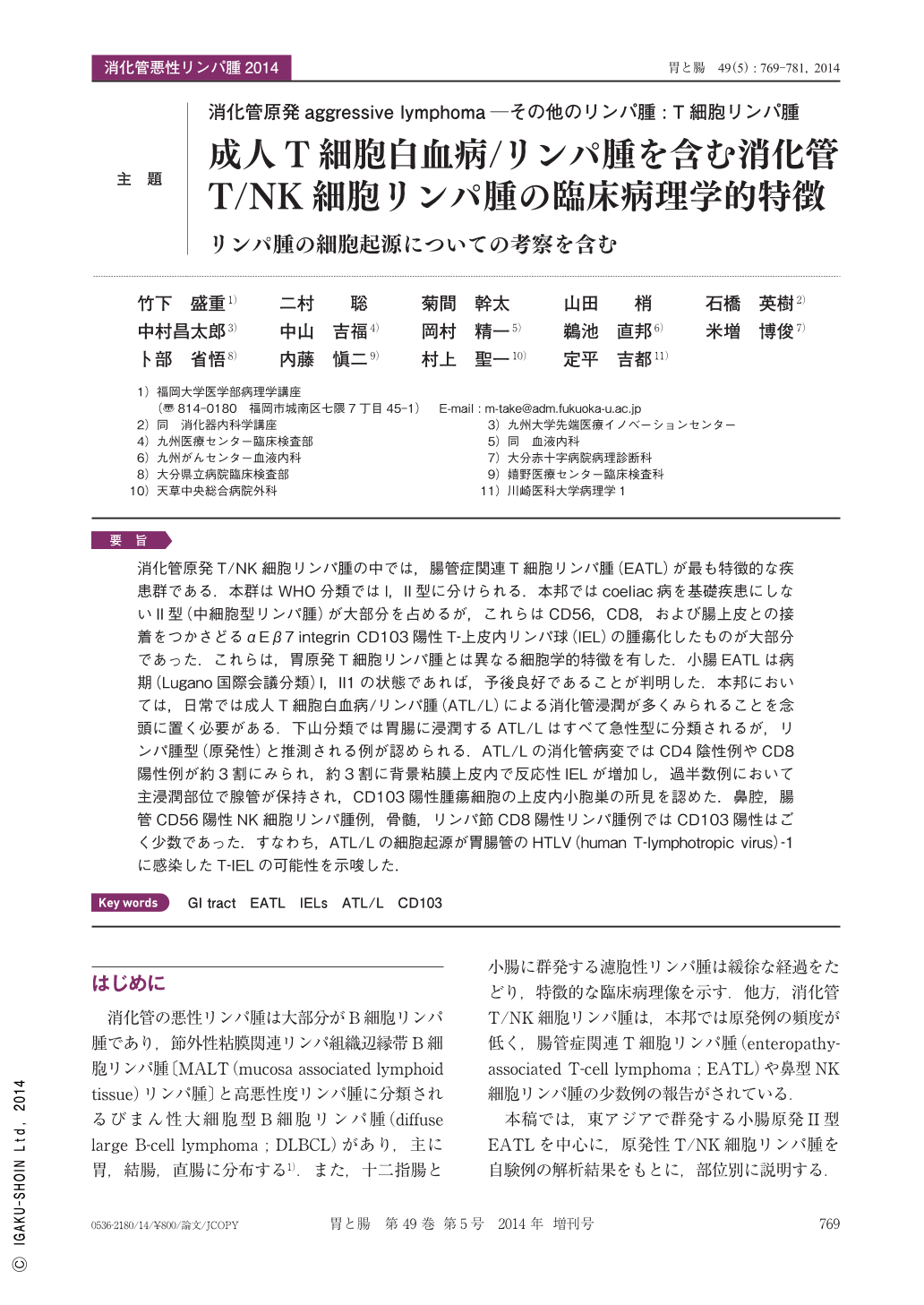Japanese
English
- 有料閲覧
- Abstract 文献概要
- 1ページ目 Look Inside
- 参考文献 Reference
- サイト内被引用 Cited by
消化管原発T/NK細胞リンパ腫の中では,腸管症関連T細胞リンパ腫(EATL)が最も特徴的な疾患群である.本群はWHO分類ではI,II型に分けられる.本邦ではcoeliac病を基礎疾患にしないII型(中細胞型リンパ腫)が大部分を占めるが,これらはCD56,CD8,および腸上皮との接着をつかさどるαEβ7integrin CD103陽性T-上皮内リンパ球(IEL)の腫瘍化したものが大部分であった.これらは,胃原発T細胞リンパ腫とは異なる細胞学的特徴を有した.小腸EATLは病期(Lugano国際会議分類)I,II1の状態であれば,予後良好であることが判明した.本邦においては,日常では成人T細胞白血病/リンパ腫(ATL/L)による消化管浸潤が多くみられることを念頭に置く必要がある.下山分類では胃腸に浸潤するATL/Lはすべて急性型に分類されるが,リンパ腫型(原発性)と推測される例が認められる.ATL/Lの消化管病変ではCD4陰性例やCD8陽性例が約3割にみられ,約3割に背景粘膜上皮内で反応性IELが増加し,過半数例において主浸潤部位で腺管が保持され,CD103陽性腫瘍細胞の上皮内小胞巣の所見を認めた.鼻腔,腸管CD56陽性NK細胞リンパ腫例,骨髄,リンパ節CD8陽性リンパ腫例ではCD103陽性はごく少数であった.すなわち,ATL/Lの細胞起源が胃腸管のHTLV(human T-lymphotropic virus)-1に感染したT-IELの可能性を示唆した.
Intestinal EATL(enteropathy-associated T-cell lymphoma)is uncommon worldwide ; it is primarily found in northern Europe. Two main types of EATLs are classified as follows. One is composed of CD8- and, CD56- negative and CD30- positive large cell lymphoma(type I)with frequent prodromal stage of Coeliac disease, and another is CD56- positive and CD8- positive or negative medium-sized lymphoma(type II). In Japan, intestinal type I EATL is rare due to the rare incidence of Coeliac disease, and the type II group is primarily found in intestinal T/NK cell lymphoma. However, enteropathy-like lesions are partly found in the non-neoplastic mucosal layer. αEβ7integrin CD103, a homing receptor of T-IEL(intraepithelial lymphocytes), was frequently found in type II EATL cases(75%). Primary gastric or colorectal EATL was infrequent. ATL/L(Adult T-cell leukemia/lymphoma)frequently invades the GI tract, but primary GI lymphoma type ATL/L was also found(29%). An increase of reactive IELs, preserved foveolar glands in involved mucosal lesions, and frequent small nests of ATL/L in epithelial glands were detected in 29%, 65%, and 43% of the 53 cases of GI tract ATL/L examined, respectively. Involved ATL/L cells expressed CD103 in over than half of the cases(57%), suggesting that ATL/L cells were derived from T-IELs in GI tracts, in which HTLV-1 was vertically transmitted via breast milk feeding from mothers to infants.

Copyright © 2014, Igaku-Shoin Ltd. All rights reserved.


